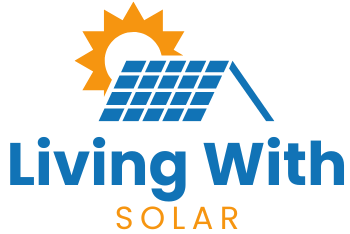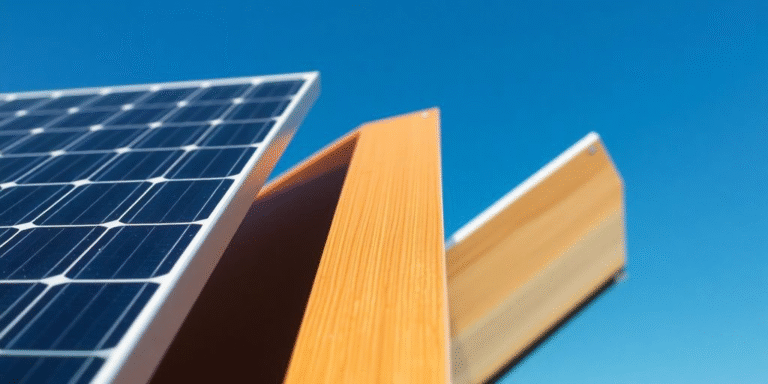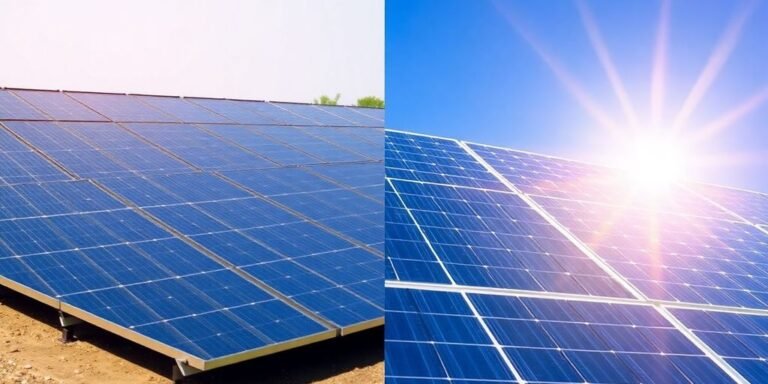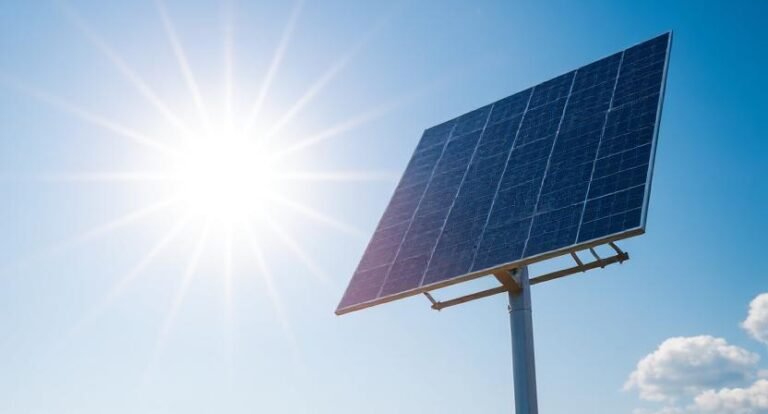Before installing solar panels, I’ve learned it’s essential to assess your roof’s condition, shape, and orientation. Make certain it can handle the weight and that water drainage won’t be obstructed.
I also suggest checking the connection requirements with your local electric grid. Plus, consider maintenance needs and financing options.
If you want to guarantee your home is perfect for solar, I can share more details to help you along the way.
Switch to Solar Today – Explore Now →
Key Takeaways
- Assess your roof for damage, age, and type to ensure it’s suitable for solar panel installation.
- Ensure your roof faces south and has an angle between 30-45 degrees for optimal sunlight exposure.
- Evaluate your roof’s load capacity and consult a structural engineer if necessary to support solar panel weight.
- Check that solar panel placement does not obstruct gutters and maintains proper water drainage.
- Familiarize yourself with the local utility’s interconnection requirements and potential fees for connecting your solar system.
Assessing Your Roof’s Condition
When I consider installing solar panels, the first thing I need to assess is my roof’s condition. A roof in good condition is vital because solar panels need a sturdy base.
I check for any signs of damage, like leaks or missing shingles, which need to be repaired before installation. It’s also essential to evaluate the age of my roof; if it’s nearing the end of its lifespan, it might need to be replaced soon.
I consider various roof types, too, as some materials may require special mounting solutions for the solar panels to be effectively installed.
Evaluating Roof Shape and Orientation
How well does your roof’s shape and orientation support solar panel installation? If you have a south-facing roof, you’re in luck—it’s ideal for maximizing sunlight exposure.
Roof angles between 30-45 degrees boost energy production, while adequate space without shading is essential for your solar panel system. Consider how different roof shapes can affect the installation process:
| Roof Shape | Installation Impact |
|---|---|
| Gable | Easy panel placement |
| Flat | Requires more structural support |
| Hip | Good for wind resistance |
| Shed | Limited space for panels |
| Monitor | Unique design, but effective |
Understanding these factors can help you make informed decisions.
Understanding Roof Load Capacity
Before moving forward with solar panel installation, it’s important to understand your roof’s load capacity. Here are some key considerations:
- Weight Assessment: Solar panels weigh between 2 to 4 pounds per square foot.
- Consult a Structural Engineer: They can evaluate your roof’s integrity and recommend reinforcements if needed.
- Local Building Codes: Guarantee compliance with regulations regarding roof load capacities.
- Weather Resilience: In regions with heavy snow or high winds, additional support may be necessary.
Regular inspections and maintenance are crucial to keep your roof structurally sound throughout the lifespan of your solar panels.
Considering Water Drainage
While I’m excited about the prospect of solar panels, it’s vital to take into account water drainage to avoid potential issues down the line.
When I decide to install solar panels, I need to guarantee they don’t obstruct existing gutters, as this can lead to improper water drainage and damage my roof.
I’ll also assess how solar panel placement impacts water runoff patterns to prevent pooling.
Proper design is important to maintain water flow around the panels. Consulting my contractor about drainage concerns and regularly inspecting the systems post-installation will help preserve my roof’s integrity and functionality.
Connecting to the Electric Grid
When I’m considering solar panels, I know I need to understand how to connect to the electric grid. This process usually involves submitting an application to my utility provider, and I should also keep in mind any connection fees that might apply.
Plus, I can benefit from net metering credits if I generate more electricity than I use, but the rules differ depending on where I live.
Connection Process Overview
As I navigate the connection process for solar panels, understanding how to link my system to the electric grid is essential. Here’s what I need to evaluate:
- Interconnection Agreement: I must apply for this with my local utility to outline my system’s connection.
- Timeframe: Depending on my utility, it could take weeks to months for approval.
- Net Metering: I need to familiarize myself with my state’s policy to maximize credits for excess energy.
- Consultation: It’s wise to talk to my installation company and utility for specific requirements, ensuring a smooth process.
Associated Fees and Credits
After managing the connection process, it’s time to evaluate the associated fees and credits linked to connecting my solar panels to the electric grid.
I need to be aware of interconnection charges, which can range considerably by utility provider. Monthly fees may apply under net metering, where I can earn credits for any excess energy back fed into the grid.
It’s essential to check local policies for potential federal tax credits and incentives that could help offset costs.
Understanding the utility’s credit system is key, as rates for generated electricity can vary, directly impacting my utility bill savings.
Researching Contractors and Trust
How can I find a trustworthy contractor for my solar panel installation? I’ve learned to prioritize a few key factors to guarantee I make the right choice:
- Contractor Reputation: Check reviews and ratings from trusted sources like the Better Business Bureau.
- Licensed and Insured: Verify that contractors are both licensed and insured for peace of mind.
- NABCEP Certification: Look for those with NABCEP certification to guarantee quality installations.
- Warranty Offerings: Compare warranty terms for equipment and installation to grasp their coverage.
Focusing on these aspects helps me find a contractor with a proven track record of successful installations.
Exploring Financing Options and Warranties
When considering solar panels, it’s essential to explore the financing options available to you, like cash purchases or solar leases, while also understanding the warranties that come with them.
I’ve found that comparing quotes from different contractors can really help in finding the best deal and coverage.
Plus, knowing the warranty terms can save you from future headaches, especially regarding repairs and installation issues.
Financing Methods Overview
Maneuvering the world of solar panel financing can feel overwhelming, but understanding your options is key to making an informed decision. Here are some financing options to take into account:
- Purchasing Solar Panels: Pay upfront for long-term savings.
- Leasing: Lower initial costs, but you won’t own the system.
- Power Purchase Agreement (PPA): Pay for the energy produced, often with no upfront cost.
- Solar Loans: Spread out installation costs while benefiting from Federal tax credits covering up to 30%.
Each option has its pros and cons, so it’s essential to evaluate what fits your financial situation best.
Warranty Types Explained
Understanding the various types of warranties for solar panels is vital if you want to protect your investment. Solar panel warranties usually cover panels for 25-30 years, guaranteeing at least 80% energy output.
Installation warranties, lasting 2-10 years, guard against poor installation, while inverter warranties range from 5-25 years. It’s important to clarify warranty terms since they often exclude issues like improper installations and normal wear.
Additionally, consider warranty transferability if you plan to sell your home; some warranties may not transfer to new owners.
Finally, evaluate the manufacturer’s reputation for warranty claims to guarantee reliable support throughout your solar panel’s lifespan.
Planning for Maintenance and Upkeep
While maintaining solar panels might seem like a minor concern, it’s essential for ensuring their long-term efficiency and productivity. Here’s what I’ve learned about planning for maintenance and upkeep:
- Cleaning: Aim for every 6 months, especially in dusty areas.
- Inspections: Schedule at least once a year to catch potential issues.
- Accessibility: Install panels for easy access to simplify cleaning and repairs.
- Warranty: Understand your warranty terms, as some may require regular maintenance to remain valid.
Frequently Asked Questions
What I Wish I Knew Before Getting Solar Panels?
Before getting solar panels, I wish I’d known about my roof’s condition, shading issues, and maintenance needs. Understanding available incentives would’ve helped too—these factors really impact the overall effectiveness and cost of my investment.
What Is the 20% Rule for Solar Panels?
When I learned about the 20% rule, it struck me: balance, efficiency, and safety. Covering no more than 20% of my roof guarantees ideal energy generation while protecting my home from potential damage and maintenance hassles.
What Is the Downside of Solar Panels on a House?
When considering solar panels, I’ve found some downsides include high initial costs, aesthetic changes, and potential maintenance. Plus, if my roof isn’t suitable, I might face additional expenses before installation even begins.
Why Is It Difficult to Sell a House With Solar Panels?
Selling a house with solar panels? It’s a breeze—if you enjoy complicated paperwork and buyers who think solar’s a burden. I’ve found many hesitate, fearing maintenance costs and uncertain benefits. Ironically, it’s often a glowing feature!





